How to Automate Policy Renewal Process Using Joget
Date
Jul 26, 25
Reading Time
15 Minutes
Category
Low-Code/No-Code Development
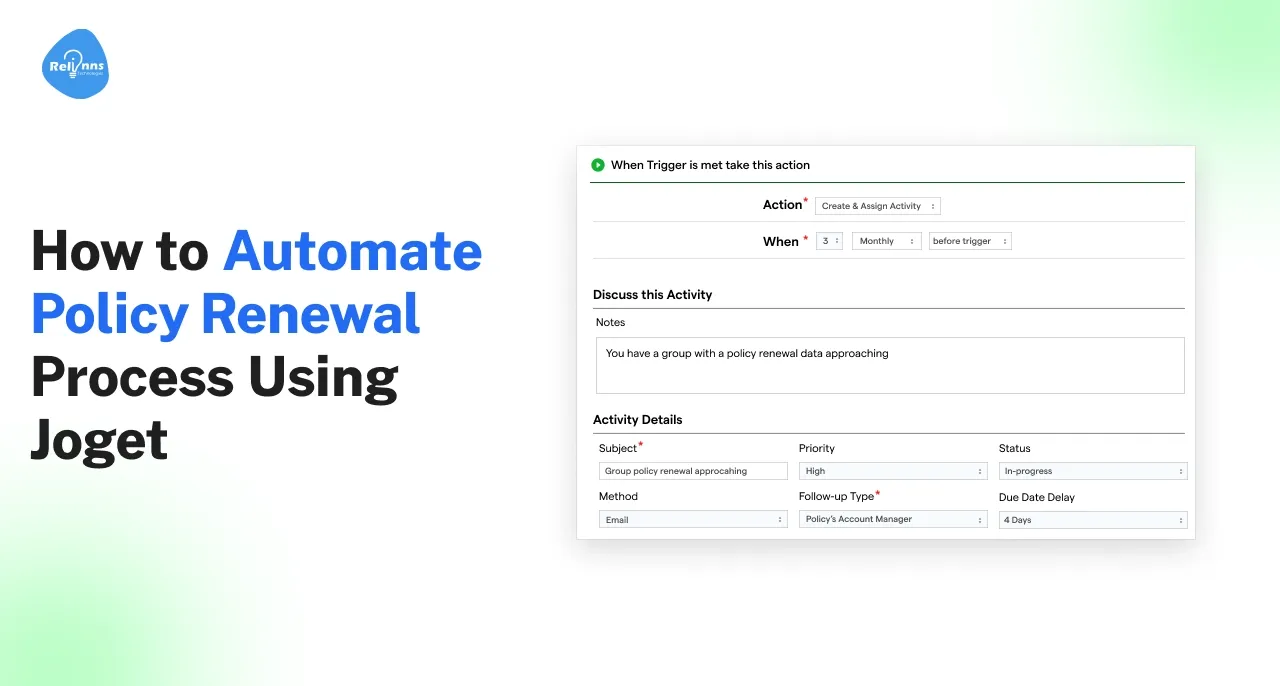
Policy renewals are critical for insurance companies, yet manual processes often cause delays, errors, and customer dissatisfaction. Each missed reminder or typo can risk coverage lapses and ultimately reduce retention rates.
With automation, insurers streamline repetitive tasks, eliminate manual mistakes, and keep renewals on schedule. This not only improves compliance but also ensures customers receive a seamless, error-free renewal experience every year.
Joget simplifies this transformation through low-code automation. In this blog, you’ll learn how to automate the policy renewal process step-by-step, and how Relinns Technologies helps insurers cut costs, improve accuracy, and retain more customers.
What is policy renewal automation?
Policy renewal automation uses software to manage your entire workflow with little to no manual involvement. The system triggers reminders, validates customer data, generates renewal quotes, and finalizes coverage - all automatically.
It can retrieve data from existing records, verify policy details, process approvals, and send documents to clients in real-time. By automating this cycle, insurers reduce human error, ensure faster renewals, and prevent policy lapses.
A typical automated policy renewal process might include sending a notice, issuing an invoice, collecting payment, auto-renewing the policy, and updating internal systems.
Modern policy renewal automation combines business process management (BPM) and robotic process automation (RPA).
BPM maps the stages of a renewal, while RPA bots or APIs automate specific tasks, such as data updates or email triggers. Tools like Joget support both approaches and can scale over time, integrating analytics, AI chatbots, and predictive models for greater impact.
Whether starting simple or going full-scale, the goal is the same: automate policy renewal process to improve speed, accuracy, and customer satisfaction.
BPM vs. RPA in Policy Renewal Automation
Feature | BPM (Business Process Management) | RPA (Robotic Process Automation) |
| Role | Maps complete policy renewal workflow | Executes specific repetitive tasks |
| Strength | End-to-end visibility and process control | Fast task execution without system overhaul |
| Use Case | Approvals, SLAs, compliance checkpoints | Data entry, notifications, CRM updates |
| Integration | Profound platform logic with Joget or other systems | Connects across legacy tools and UI-based software |
| Best When | You want to automate policy renewal process holistically | You need quick wins in automating policy renewals |
Why is Joget ideal to automate the policy renewal process at scale?
Joget is a no-code/low-code platform built for business automation. It allows you to design renewal workflows visually without requiring heavy coding.
The platform combines simple drag-and-drop tools with enterprise-level security and scalability, making it an ideal solution for insurers. Specifically, Joget runs on a robust architecture that can securely handle thousands of transactions.
It is designed so that business users (not just programmers) can adjust processes on the fly, giving you flexibility to adapt to change.
- Visual Builder
- Design renewal workflows visually using drag-and-drop, no coding required.
- Configure reminders, approvals, and documents within minutes using templates
- Quickly launch automated policy renewals with prebuilt form components.
- Customize steps for different policy types using visual logic tools.
- Reduce setup time by 70% with Joget’s intuitive workflow builder.
- Integration-Ready
- Connect Joget with CRM, billing, and policy systems seamlessly.
- Use built-in connectors for email, SMS, and web services.
- Sync customer data instantly without writing complex integration code.
- Automate policy renewal process across systems with real-time syncing.
- Link Joget to payment gateways for auto-renewal and invoicing.
- Plugins & APIs
- Extend Joget easily using open APIs and flexible plugin support.
- Add e-signature functionality for faster, paperless policy renewals.
- Integrate compliance tools directly into your renewal workflow steps.
- Customize automated policy renewals with third-party system compatibility.
- Build scalable features using Joget’s developer-friendly plugin framework.
- Templates
- Use prebuilt templates from Joget to accelerate the renewal setup process.
- Relinns provides ready-made workflows for automated policy renewals instantly.
- Save development time using Joget’s insurance-specific template library.
- Customize existing apps to match your unique renewal process needs.
- Deploy automation faster with templates built by Relinns' experts.
- Fast Deployment
- Launch Joget apps from concept to production within weeks easily.
- Begin with one renewal flow, then gradually expand automation.
- Build MVPs quickly to test automated policy renewals effectively.
- Scale renewal automation across products with Joget’s flexible framework.
- Accelerate rollout using Joget’s fast deployment and modular design.
- Scalability
- Enterprise-grade platform supports thousands of users and policies seamlessly.
- Assign custom roles and permissions across your renewal automation teams.
- Maintain compliance with detailed audit logs for every policy action.
- Scale automated policy renewals without compromising performance or security.
- Manage complex insurance operations using Joget’s robust enterprise features.
- Open Source
- Joget is open-source, reducing expensive licensing and vendor lock-in.
- Choose flexible hosting: deploy on cloud or on-premise environments.
- Scale automated policy renewals without infrastructure limitations or restrictions.
- Retain control over data, deployment, and compliance with Joget.
- Optimize costs while customizing renewals using Joget’s open-source.
Joget’s low-code approach empowers your team to easily customize the renewal process. Insurance executives report that platforms like Joget can expedite work and minimize errors.
In other words, Joget helps insurers automate policy renewal process faster, with built-in monitoring and error-checking to ensure each renewal is completed correctly.
Many insurers choose Joget for this agility since business users can update renewal rules without coding.
How can you automate policy renewals in Joget step by step?
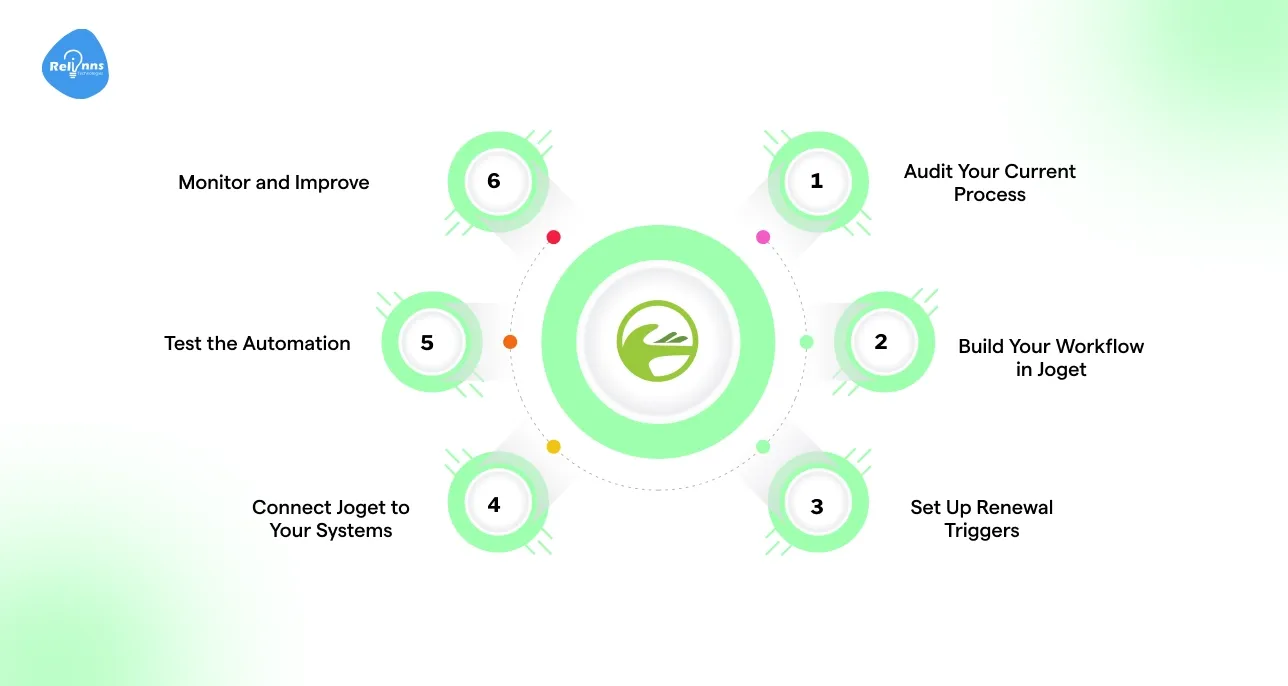
Automating your policy renewals begins with understanding your current situation.
This step-by-step approach will guide you through mapping your current process, building workflows in Joget, integrating systems, testing functionality, and optimizing for efficiency, scale, and compliance.
Step 1: Audit your current process
Before automation begins, analyze how your current renewal process works, step by step. Understanding gaps upfront ensures more innovative automation later.
- Identify manual touchpoints such as reminders, approvals, and document handling across the current renewal workflow.
- Track key renewal cycle metrics, including turnaround time, error frequency, drop-off rates, and customer response delays.
- Collaborate with agents, IT, and compliance teams to uncover inefficiencies and improvement opportunities in workflows.
A clear process map helps you automate the policy renewal process, which improves speed and accuracy the most.
Step 2: Build your workflow in Joget
Now that you’ve mapped your manual process, it’s time to digitize it. Joget helps you automate the policy renewal process with visual tools, customizable forms, and flexible logic components.
- Use Joget’s drag-and-drop builder to create your entire renewal process from start to finish visually.
- Build forms to collect updated policyholder data, endorsements, and custom renewal requirements quickly.
- Add rules for automated calculations, such as premium adjustments and renewal eligibility validations.
This structured setup allows you to automate policy renewal process without complex development cycles.
Step 3: Set up renewal triggers
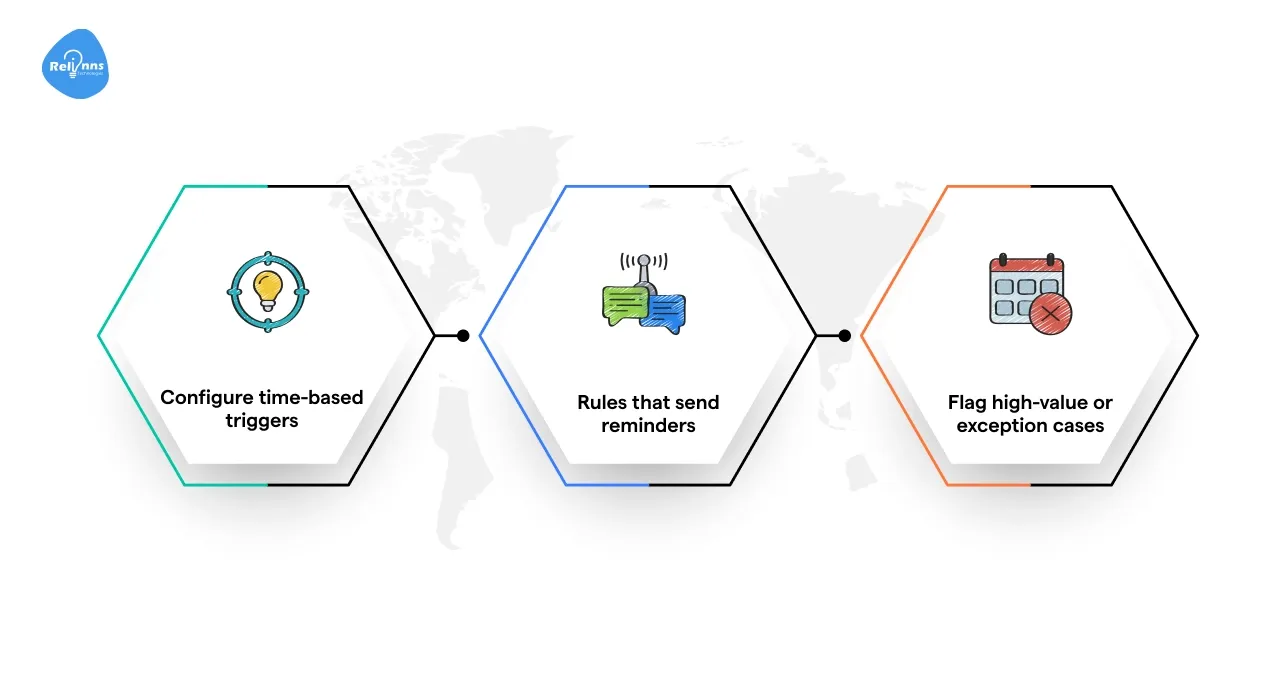
Setting up intelligent triggers in Joget ensures every policy renewal starts automatically and on time. This eliminates guesswork, reduces delays, and helps you consistently automate the policy renewal process across products.
- Configure time-based triggers like “30 days before expiry” to auto-launch the renewal workflow.
- Set up rules that send reminders via email or SMS based on timing and policy type.
- Flag high-value or exception cases to ensure manual reviews happen before automatic policy renewal execution.
These triggers ensure you automate policy renewal process predictably, without needing manual oversight or last-minute rushes.
Step 4: Connect Joget to your systems
Seamless integration is crucial for automating the policy renewal process across departments without silos or manual syncing. Joget facilitates this with built-in connectors, APIs, and real-time data exchange features.
- Use REST APIs to sync Joget with CRM, billing, and policy management systems automatically.
- Connect payment gateways to trigger confirmations and update renewal status after successful transactions.
- Integrate document storage, SMS, and email tools to streamline communication and recordkeeping during renewals.
These integrations help automate policy renewal process fully while keeping your data clean, synced, and up-to-date.
Suggested Reading: What are Low Code Automated Insurance Policy Renewals?
Step 5: Test the automation
Thorough testing ensures your workflow works under every condition—normal, edge-case, or failure. Before going live, validate every step to guarantee a reliable and complete automated policy renewal process.
- Simulate scenarios such as valid renewals, missing data, and failed payments to test the system's reactions.
- Check that reminders, approvals, and confirmations are triggered correctly at every workflow stage.
- Verify successful payments, update databases, and trigger policy document generation without errors.
Testing guarantees you truly automate the policy renewal process without breakdowns or missed exceptions in production.
Step 6: Monitor and improve
Once your automation is live, the work isn’t over. Ongoing monitoring helps refine workflows, fill gaps, and ensure that you continue to automate policy renewal process more effectively over time.
- Utilize Joget dashboards to track renewal rates, bounces, exceptions, and the frequency of manual interventions.
- Analyze trends to improve timing, trigger logic, reminder content, and approval routing paths.
- Clean up insufficient data regularly and adjust rules to minimize delays or incomplete renewals.
Iterative improvements help you continually optimize and scale the automation of your policy renewal process.
What can you automate to streamline the policy renewal process?
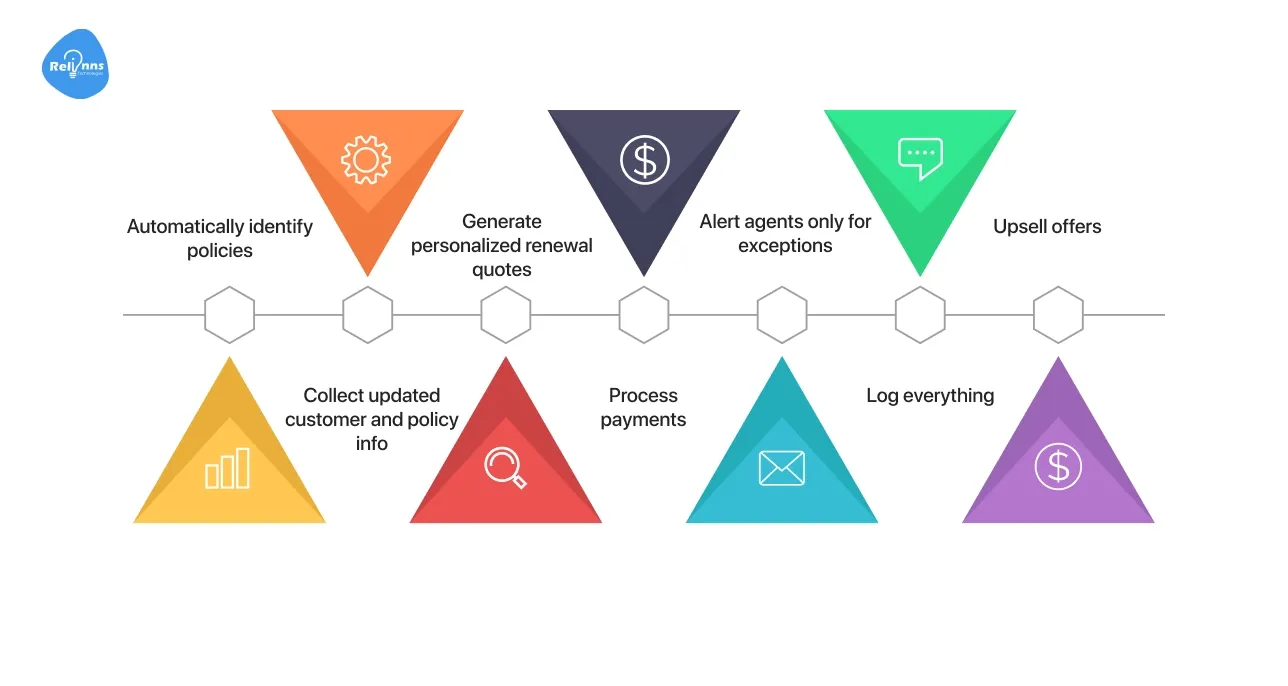
Many day-to-day renewal tasks can be automated end-to-end. For instance, Joget can automatically send reminders at key dates, gather updated information through online forms, and even recalculate premiums based on new data.
Any repetitive, data-driven step in your renewal process is a candidate for automation.
- Automatically identify policies expiring soon and send renewal notices to customers.
- Collect updated customer and policy info through online forms and auto-validate entries.
- Generate personalized renewal quotes or documents and email them without delay.
- Process payments: Integrate digital billing to confirm renewals and update policy status.
- Alert agents only for exceptions: set triggers for failed payments or special approvals.
- Log everything: once renewed, record the transaction and update your systems automatically.
- Upsell offers: Include cross-sell or loyalty offers in the renewal notice.
- For example, automatically suggest a coverage upgrade or loyalty discount when relevant.
By having the system handle these routine steps, staff can focus solely on exceptions while ensuring that every renewal task is completed.
Customers receive timely and consistent communication throughout the process. In one case, implementing renewal automation cut processing time by over 75%, turning hours of work into minutes.
Automating tasks like these helps insurers reduce errors, speed up cycles, and maintain a higher number of active policies.
What results can you expect from automating the policy renewal process?

Automation yields clear ROI for insurers. For example, one case study showed that on-time renewals jumped from 60% (manual) to 93%, while labor time plummeted.
McKinsey reports that manual, non-digital insurance workflows suffer massive inefficiencies that automation can eliminate.
Typical results include the following.
- Fewer errors: Insurers report an 80–90% drop in manual data-entry errors and a 20–25% boost in employee productivity.
- More on-time renewals: Automated workflows achieve ~93% on-time renewals, versus just 60% manually.
- Lower costs: Many firms cut back-office processing costs by roughly 20–65% after automating renewals.
- Time savings: In one example, automating renewals cut processing time by 75%, turning lengthy tasks into minutes.
- Higher retention: Since industry retention rates are about 84%, even a small lift from automation can retain many more customers.
- Better loyalty: Faster, error-free renewals lead to happier customers who are more likely to renew again.
These benefits stack up fast. By retaining more policies and reducing labor, most insurers see automation pay back in months rather than years.
Even small changes add up: on a $10 million portfolio, raising retention by 3% yields $ 300,000 in extra premium each year, often covering the cost of automation many times over.
What common pitfalls can disrupt your automated policy renewals process?
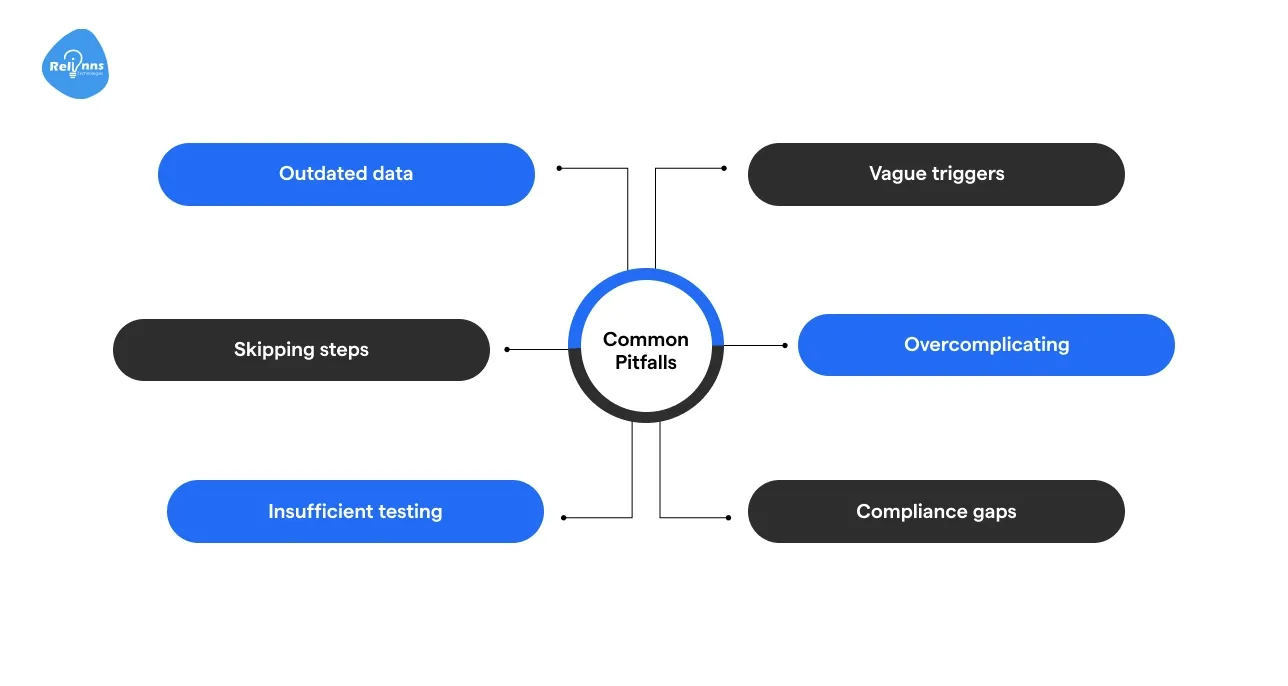
Even the best technology can fail if not implemented carefully. Common mistakes often stem from planning and data-related issues.
- Vague triggers: If rules aren’t specific (e.g., “near expiry”), workflows may fire at the wrong time or not at all.
- Outdated data: Automating with old customer info leads to failures. For example, reminders bounce if email addresses are wrong.
- Skipping steps: Don’t skip post-renewal actions. Always send confirmation notices and updated documents after a renewal.
- Overcomplicating: A complex, branching workflow can be hard to maintain. If one step fails, many renewals may be halted.
- Insufficient testing: Pushing automation live without thorough testing can leave gaps. Always pilot your workflow on small batches first
- Compliance gaps: If your automated flow omits required checks, you could face regulatory issues. Implement compliance steps and logs as needed.
For example, one insurer found that automating renewals without sending a final email confirmation caused customer confusion.
Careful planning, clean data, and incremental rollout help you avoid these issues.
What best practices ensure the successful automation of the policy renewal process using Joget?
For maximum impact, follow these proven best practices when setting up your Joget renewal workflows.
Keep data clean
- Verify customer contact details to ensure reminders reach the right recipient.
- Remove outdated records to avoid failed notifications or renewal delays.
- Clean data helps automate the policy renewal process with higher accuracy.
Clear templates
- Use proven templates for consistent renewal reminders and confirmations.
- Personalize messages with policyholder names, dates, and key details.
- Branded templates improve engagement in communication.
Manual overrides
- Enable manual overrides for exceptions like complex coverage or compliance.
- Add a “hold” option to pause automation when needed.
- Agents to intervene during the automated policy renewal process for exceptions.
Proactive communication
- Send timely reminders so customers act before policy expiration dates.
- Deliver confirmation messages to build trust and ensure transparency.
- Keep clients updated throughout the automated policy renewal process journey.
Monitor metrics
- Monitor renewal rates to measure automation performance over time.
- Track errors and manual steps to identify process bottlenecks.
- Utilize insights to refine automated policy renewal workflows continually.
User training
- Train staff thoroughly to navigate the new automated renewal system.
- Offer clear documentation for every step in the workflow.
- Teams to manage automated policy renewals confidently and independently.
Automation mindset
- Identify repetitive tasks that are easily supported by automated policy renewals.
- Continuously optimize workflows to improve automation efficiency and scalability.
- Make automation a mindset across all renewal-related operational activities.
Full automation
- Customize Joget workflows for each policy type and renewal stage.
- Ensure full automation covers product-specific steps and compliance needs.
- Build renewal flows that scale across all policy product lines.
Continuous aim
- Review completed workflows to ensure no manual steps remain.
- Validate automation coverage after update changes to ensure continuous quality.
- Refine tasks regularly to maintain a fully automated policy renewal process.
Integration
- Integrate CRM, billing, and email tools for seamless data flow.
- Connect systems to eliminate manual entry during policy renewals.
- Automate the policy renewal process by syncing data across platforms instantly
Document flows
- Document each workflow step during every app update or change.
- Maintain clear records to support consistent process automation practices.
- Help teams sustain and scale the automated policy renewal process effectively.
Following these steps ensures every renewal flows smoothly from start to finish, boosting customer satisfaction and internal efficiency.
How can you begin and automate the policy renewal process with confidence?
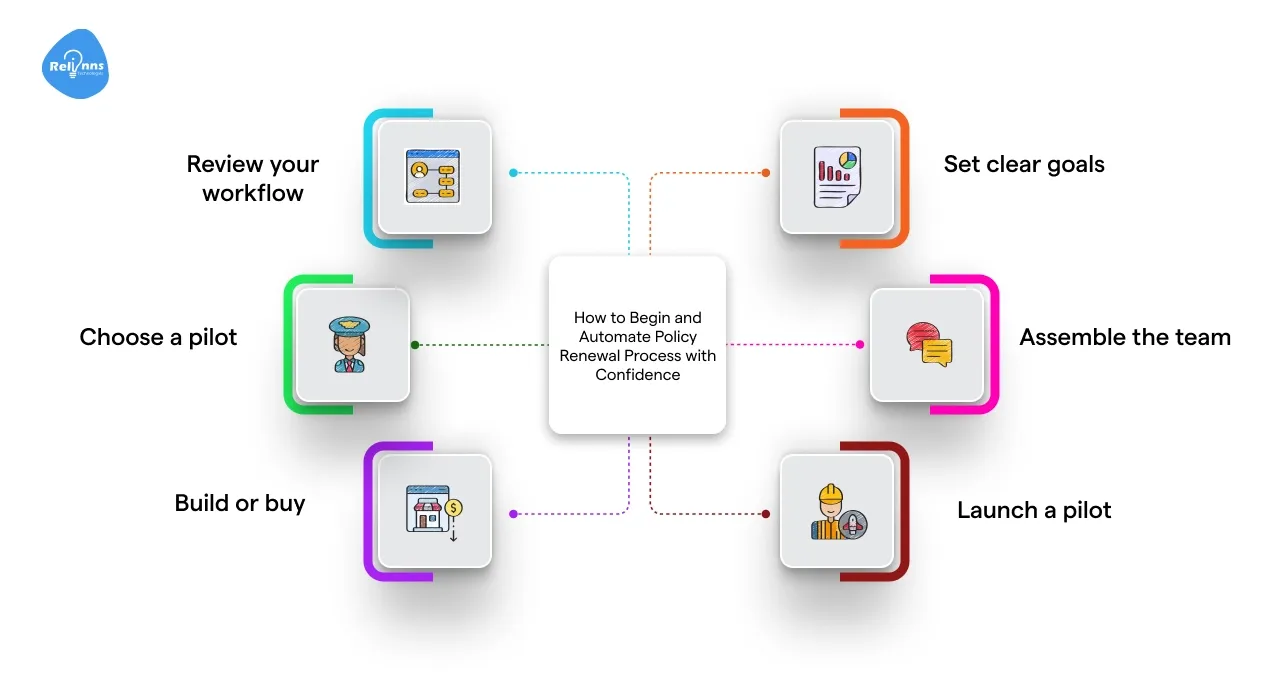
Starting your automation journey doesn’t require a massive overhaul—just a smart, strategic first step. With the right tools and approach, you can confidently automate policy renewal process from day one.
- Review your workflow: Map out the current policy renewal process and identify pain points or bottlenecks.
- Set clear goals: Determine what success looks like (e.g., improve on-time renewal rate by X% or cut processing time by Y%).
- Choose a pilot: Start with one product line or customer segment to automate first.
- Assemble the team: Include IT, insurance operations, and end-users so that everyone’s needs are met.
- Build or buy: Decide whether to develop in-house on Joget or engage experts. Partners like Relinns can jump-start your project with ready components.
- Launch a pilot: Test the automation on the pilot group and gather feedback.
Once you see positive results, scale the automation to more policies.
Conclusion:
Automating your policy renewal process isn’t just a tech upgrade—it’s a business advantage. From reducing errors to boosting customer satisfaction, automation helps insurers operate leaner, faster, and smarter.
With tools like Joget and the right partner to implement it, you’re not just improving efficiency—you’re building a future-ready system that grows with you.
The sooner you begin, the sooner you unlock higher retention, reduced costs, and a real competitive edge.
Why Choose Relinns Technologies?
Relinns Technologies is your ideal partner for automating the policy renewal process—whether you need a complete build or just a boost in speed and scale.
- Cut development costs by 70% with offshore Relinns automation experts.
- Launch MVPs 50% faster using agile low-code Joget workflows.
- Achieve 90% automation coverage across policy renewal operations reliably.
- Reduce policy errors by 75% through tested, white-labeled Joget apps.
- Boost on-time renewals by 60% with Relinns’ automated integration solutions.
If you're serious about achieving truly automated policy renewals, Contact Relinns helps you get there—faster, better, and without breaking the bank.
Frequently Asked Questions (FAQs)
How can automation improve compliance during policy renewals?
Automated policy renewals ensure regulatory compliance by embedding approval logs, validation steps, and audit trails into every workflow, minimizing the risk of missed checkpoints or documentation gaps.
Can we automate policy renewal process across different insurance product lines?
Yes, insurers can automate the policy renewal process for life, health, auto, and specialty policies using modular low-code workflows that adapt to varying regulatory and operational requirements.
How does the automated policy renewal process affect customer lifetime value?
Automated policy renewals reduce friction, increase on-time renewals, and improve customer experience—factors that directly boost customer lifetime value and reduce churn over the long term.
What integrations are critical for successful policy renewal automation?
To fully automate the policy renewal process, you need integrations with CRMs, billing systems, document storage tools, and communication channels, such as SMS and email platforms.
Is it possible to personalize communications in automated policy renewals?
Yes, using dynamic fields and templates, insurers can personalize every message in the automated policy renewal process, enhancing engagement and improving conversion rates.
What KPIs should we track in an automated policy renewal process?
Track KPIs like on-time renewal rate, exception volume, bounce rates, SLA adherence, and manual intervention frequency to optimize your automated policy renewals strategy.


